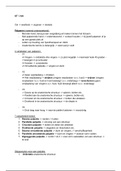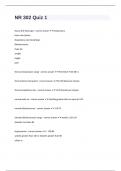1. OVERVIEW OF COMPUTER
Definition: “Computer is an electronic machine that can store, recall and process
data. It can perform tasks or complex calculation according to a set of
instructions or programs”.
Functionalities of a Computer:
Step 1 − Takes data as input.
Step 2 − Stores the data/instructions in its memory and uses them as required.
Step 3 − Processes the data and converts it into useful information.
Step 4 − Generates the output.
Step 5 − Controls all the above four steps.
Characteristics of Computer:
1. Speed: The computer works very fast. The speed of Computer is measured in
terms of MIPS (Million Instructions Per Second) or BIPS (Billion Instructions
Per Second
2. Storage Capacity: The computer can store a large volume of data and
information. The storage capacity of the computer is measured in terms of
Bytes. A group of 8 Bits is called a Byte.
3. Accuracy: The computer-generated results are exact and without any mistakes
with high rate of consistency.
4. Diligence: Unlike human beings, a computer does not suffer from limitations
like tiredness and lack of concentration. It can work for hours without making
any errors.
5. Versatility: Computers are used in almost all the areas.
6. Flexibility: Flexibility would involve the number of things you can do with a
computer. While some are best used for simple business tasks, and filing of
tasks, others are good for multimedia, gaming, and so on.
7. Cost effectiveness: Computers reduce the amount of paper work and human
effort, thereby reducing costs.
, Advantages of Computers:
1. Multitasking: We can do multiple tasks, multiple operations at same time.
2. Speed: One of the most advantages of computer is its speed, which helps
human to finish their task in few seconds.
3. Accuracy: Computer will perform all calculation and operation with accuracy.
(True value / Recognized standard)
4. Storage: storage capacity of computer is usually in GB or more, so we can
store more data.
5. Data security: Computer provides protection for our data such as files,
database and information.
6. Automation: the computer can also be used to automate regular tasks.
7. Versatile: computers have capacity to perform completely different type of
work.
Disadvantages of Computers:
1. Virus and hacking attacks
2. Online Cyber Crimes
3. High Cost
4. It may create Unemployment
5. Impact on the environment
6. Higher dependency on electronic gadgets
7. Wasting time on unnecessary things
Components of Computer system:
There are four components in the computer system. They are:
1. Hardware: The physical parts of a computer system called as hardware.
Example Keyboard, Mouse, Monitor, Printer, RAM, CPU etc.
2. Software: A Set or collection of programs is known as software. Example
Operating System, TUX Paint, Office Packages, Nudi, Adobe Reader, Computer
Games etc.
,The software is broadly classified into two types. They are
1. System Software: It is a type of computer program that is designed to control
and to run a computer's hardware and application programs. Example:
Microsoft Windows, Linux, DOS etc.
2. Application software: It is a type of Software written by the user to perform a
particular task. Example: Paint, Nudi and Office Package etc.
Data: Data is a collection of unprocessed items, which can include text, numbers,
audio or video. Data is the raw information or basic facts that computer can
process.
User(s): People who use the computers are called users. These computer
operators are called computer users.
Functional Components of a Computer:
Basically any computer is supposed to carry out the following functions.
Accepts the data and program as input.
Stores the data, program and retrieve as and when required.
Process the data as per instructions given by the program and convert it into
useful information.
Communicate the information as output.
Block diagram of a Computer:
, Input Unit: The device which is used to input or feed the data in to computer
system. Example: Keyboard, Mouse.
Central Processing Unit (CPU): It is the main part of a computer system. It
processes the input and generates the desired output with high speed and
greater accuracy. It consists of two major units.
Control Unit: It controls and directs the transfer of program instructions
and data between various units.
Arithmetic and Logic Unit (ALU): It performs arithmetic (+, - ,*, /) and
logical (AND, OR, NOT) operations.
Memory Unit: The data and the instructions required for processing have to be
stored in the memory unit before they are processing.
Primary memory: It is also called as main memory. It holds the program
that are currently executing. It includes RAM (Read Access memory), ROM
(Read only memory).
Secondary memory: It stores the large amount of data permanently. It is
less expensive .Commonly used devices are DVD, Pen drive etc.
Note: The input unit, an output unit, and secondary storage devices are
together known as Peripheral Devices.
Output Unit: The device used to print and the results is called output device.
Example: Monitor, Printer, Speaker etc.
Evolution of computer:
1. Abacus (2500 BC):
It was the first machine used for counting and calculating.
It is made of a wooden frame, metal rods, and wooden beads .Abacus was
mainly used for addition, subtraction.
2. Napier’s bones (1614 AD):
It was invited by John Napier, a Scottish mathematician.
It has 9 bones or roads and each bone is representing decimal digits.
It is mainly used for multiplication.
3. The slide Rule (1633 AD):
The slide Rule was invented by William Oughtred.
It uses logarithms to perform multiplication and division using addition and
subtraction method.
The slide rule is embodied by the two sets of scales that are joined together, with
a marginal space between them.
Definition: “Computer is an electronic machine that can store, recall and process
data. It can perform tasks or complex calculation according to a set of
instructions or programs”.
Functionalities of a Computer:
Step 1 − Takes data as input.
Step 2 − Stores the data/instructions in its memory and uses them as required.
Step 3 − Processes the data and converts it into useful information.
Step 4 − Generates the output.
Step 5 − Controls all the above four steps.
Characteristics of Computer:
1. Speed: The computer works very fast. The speed of Computer is measured in
terms of MIPS (Million Instructions Per Second) or BIPS (Billion Instructions
Per Second
2. Storage Capacity: The computer can store a large volume of data and
information. The storage capacity of the computer is measured in terms of
Bytes. A group of 8 Bits is called a Byte.
3. Accuracy: The computer-generated results are exact and without any mistakes
with high rate of consistency.
4. Diligence: Unlike human beings, a computer does not suffer from limitations
like tiredness and lack of concentration. It can work for hours without making
any errors.
5. Versatility: Computers are used in almost all the areas.
6. Flexibility: Flexibility would involve the number of things you can do with a
computer. While some are best used for simple business tasks, and filing of
tasks, others are good for multimedia, gaming, and so on.
7. Cost effectiveness: Computers reduce the amount of paper work and human
effort, thereby reducing costs.
, Advantages of Computers:
1. Multitasking: We can do multiple tasks, multiple operations at same time.
2. Speed: One of the most advantages of computer is its speed, which helps
human to finish their task in few seconds.
3. Accuracy: Computer will perform all calculation and operation with accuracy.
(True value / Recognized standard)
4. Storage: storage capacity of computer is usually in GB or more, so we can
store more data.
5. Data security: Computer provides protection for our data such as files,
database and information.
6. Automation: the computer can also be used to automate regular tasks.
7. Versatile: computers have capacity to perform completely different type of
work.
Disadvantages of Computers:
1. Virus and hacking attacks
2. Online Cyber Crimes
3. High Cost
4. It may create Unemployment
5. Impact on the environment
6. Higher dependency on electronic gadgets
7. Wasting time on unnecessary things
Components of Computer system:
There are four components in the computer system. They are:
1. Hardware: The physical parts of a computer system called as hardware.
Example Keyboard, Mouse, Monitor, Printer, RAM, CPU etc.
2. Software: A Set or collection of programs is known as software. Example
Operating System, TUX Paint, Office Packages, Nudi, Adobe Reader, Computer
Games etc.
,The software is broadly classified into two types. They are
1. System Software: It is a type of computer program that is designed to control
and to run a computer's hardware and application programs. Example:
Microsoft Windows, Linux, DOS etc.
2. Application software: It is a type of Software written by the user to perform a
particular task. Example: Paint, Nudi and Office Package etc.
Data: Data is a collection of unprocessed items, which can include text, numbers,
audio or video. Data is the raw information or basic facts that computer can
process.
User(s): People who use the computers are called users. These computer
operators are called computer users.
Functional Components of a Computer:
Basically any computer is supposed to carry out the following functions.
Accepts the data and program as input.
Stores the data, program and retrieve as and when required.
Process the data as per instructions given by the program and convert it into
useful information.
Communicate the information as output.
Block diagram of a Computer:
, Input Unit: The device which is used to input or feed the data in to computer
system. Example: Keyboard, Mouse.
Central Processing Unit (CPU): It is the main part of a computer system. It
processes the input and generates the desired output with high speed and
greater accuracy. It consists of two major units.
Control Unit: It controls and directs the transfer of program instructions
and data between various units.
Arithmetic and Logic Unit (ALU): It performs arithmetic (+, - ,*, /) and
logical (AND, OR, NOT) operations.
Memory Unit: The data and the instructions required for processing have to be
stored in the memory unit before they are processing.
Primary memory: It is also called as main memory. It holds the program
that are currently executing. It includes RAM (Read Access memory), ROM
(Read only memory).
Secondary memory: It stores the large amount of data permanently. It is
less expensive .Commonly used devices are DVD, Pen drive etc.
Note: The input unit, an output unit, and secondary storage devices are
together known as Peripheral Devices.
Output Unit: The device used to print and the results is called output device.
Example: Monitor, Printer, Speaker etc.
Evolution of computer:
1. Abacus (2500 BC):
It was the first machine used for counting and calculating.
It is made of a wooden frame, metal rods, and wooden beads .Abacus was
mainly used for addition, subtraction.
2. Napier’s bones (1614 AD):
It was invited by John Napier, a Scottish mathematician.
It has 9 bones or roads and each bone is representing decimal digits.
It is mainly used for multiplication.
3. The slide Rule (1633 AD):
The slide Rule was invented by William Oughtred.
It uses logarithms to perform multiplication and division using addition and
subtraction method.
The slide rule is embodied by the two sets of scales that are joined together, with
a marginal space between them.



